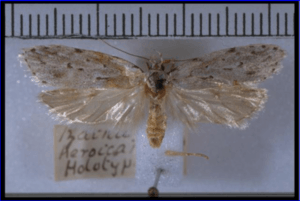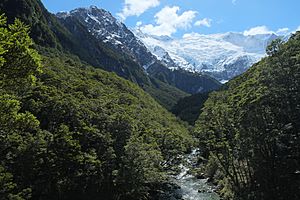Izatha heroica facts for kids
Quick facts for kids Izatha heroica |
|
|---|---|
 |
|
| Scientific classification | |
| Kingdom: | |
| Phylum: | |
| Class: | |
| Order: | |
| Family: |
Oecophoridae
|
| Genus: | |
| Species: |
I. heroica
|
| Binomial name | |
| Izatha heroica Philpott, 1926
|
|
| Synonyms | |
|
|
Izatha heroica is a type of moth that belongs to the Oecophoridae family. This moth is special because it is found only in New Zealand. It lives mostly in the western part of the South Island. Young moths, called larvae, have been found living on dead kanuka or manuka bushes.
Contents
How This Moth Got Its Name
The Izatha heroica moth was first described in 1926 by a scientist named Alfred Philpott. He studied a female moth found near Flora River, Mount Arthur. The original specimen, called a holotype, is kept at the New Zealand Arthropod Collection.
Later that same year, another scientist, Charles E. Clarke, thought he had found a new species. He named it Izatha toreuma. He used a male moth from Arthurs Pass. This specimen is now at the Auckland War Memorial Museum.
However, in 1928, George Hudson realized that Izatha toreuma was actually the same moth as Izatha heroica. So, Izatha toreuma became a synonym (another name) for Izatha heroica.
What Does the Heroic Moth Look Like?
The Izatha heroica moth is quite large for a moth. Its wingspan (the distance from one wingtip to the other) is about 23 to 29 millimeters for males. Females are a bit bigger, with a wingspan of 27 to 32 millimeters.
The head and body of the moth are mostly white. Its feelers, called palpi, are white with some black markings. The antennae are a mix of dark and white colors. The main body part, called the abdomen, is a yellowish-white color. Its legs are grayish-white with dark bands on the feet.
The front wings are long and wide, mostly white with many pale brownish-gray spots. They have seven dark spots along the front edge, and other dark spots scattered across the wing. There's also a line of dark spots along the outer edge of the wing. The back wings are grayish-white with a faint dark spot in the middle.
This moth is known for its larger size compared to similar species. It also has grayish front wings and does not have a cone-shaped bump on its head, which helps tell it apart from other moths. Adult moths have been seen flying in January, February, and early March.
Where Does This Moth Live?
The Izatha heroica moth is endemic to New Zealand. This means it is found naturally nowhere else in the world. It lives only on the South Island.
While it prefers the western side of the island, it has been found in many different areas. These include Nelson, Marlborough, Marlborough Sounds, Westland, Fiordland, North Canterbury, Buller, Otago Lakes, Central Otago, and Southland.
Heroic Moth's Home and Habits
This moth likes to live in wetter forests on the western side of the South Island. This includes forests with Nothofagus trees, which are also known as beech trees.
The young moths, or larvae, have been found living on dead Leptospermum plants. These plants might have been Kunzea ericoides (kanuka) or Leptospermum scoparium (manuka). Both of these plants were once grouped under the Leptospermum name.
Finding the larvae on these plants suggests that the moth might not need beech forests to survive. This moth is also known to be attracted to light.



